Nearly 16 years ago, when Ritusmita Talukdar (30) a lead artiste of Nagara Naam, decided to form a female team to perform the popular Assamese art form, she unknowingly had to prepare herself to contest cultural patriarchy. For, Nagara Naam-a unique cultural practice in Assam was then considered to be a male domain, and she had to face resistance from relatives, neighbours and other members of the society.
Then a student of Class IX, Ritusmita, however, was not ready to bow down to the pressure.
Ritusmita Talukdar and Subhash Nath(Photo - Ratna Bharali Talukdar)
“I was passionate to perform Nagara Naam. My father was also the lead artiste of a Nagara Naam performing team and he did not object. There was, however, stiff resistance from relatives and other member of the society. Nagara Naam was performed only by males in our localities. Their resistance only made me stand firm on my decision,” Ritusmita says.
Finally, Ritusmita formed a female Nagara Naam team--Jadumoni Sowali Nagara Naam Dal in her ancestral village Moripur in Bajali Sub-division in Barpeta district in Assam. Initially, very few families came forward to allow their daughters to perform with her. As Nagara naam is performed mostly evening through nights, parents hesitated to permit their daughters to perform in the team.
The tug-of-war continued for some time. Then, things changed drastically, for the better.
Dulu Moni Nath and her daughter (Photo - Ratna Bharali Talukdar)
“One day, I received an invitation to perform in Tihu in neihbouring Nalbari district. People were curious to witness performance of a young female Nagara Naam team, after they had heard about the formation of our team. To our surprise, they also promised us to pay Rs.2000 as payment to Artistes. Prior to that people used to offer something to such teams after performance, but no cash payment was promised”, she adds narrating her journey.
People in Tihu loved the performance and soon after that they were invited to perform in Bhabanipur in Barpeta district. This time, they were promised payment of Rs.2,500. Within months, Ritushmita’s team became a household name in those areas where Nagara Naam is a popular folk culture.
Dibakar Baruah and Atul Baruah (Photo -Ratna Bharali Talukdar)
“All of my team members including me belonged to poor farm families. Agriculture became non-remunerative and our parents faced lots of hardship. It did not take much time for us to take performance of Nagara Naam as an alternative livelihood. We could also purchase instruments depositing some amount. To provide support, my parents always accompanied us”, says Ritushmita, a graduate from Bajali College, stating that the earning was of great help to them.
She now lives in Nij Sipajhar village of Darrang district with her husband Subhash Nath, a renowned Nagara Naam artiste and a folk singer in Assam, and her son.
Nagara Naam is a folk-cultural practice and a performing art-form mostly prevalent in lower and northern Assam, where devotional songs are performed with musical tunes of Nagara and Taal(cymbal). Singing, dancing and acting of Pathak, the lead artiste, is the centre of attraction of the performance for the audience. There are at least six Palis with cymbals in hand to accompany the Pathak, two Nagoru (who plays the Nagara, a percussion instrument) and a Taluwoi (the lead Cymbalist) in a team. A team normally performs two or three such devotional songs. The performance continues for at least three hours. However, depending on demands of the crowd, a team may have to perform for six to seven hours at a stretch.
Naba Kumar Saikia, the General Secretary of Darrang Kala Kristi Unnayan Sangha
(Photo -Ratna Bharali Talukdar)
“Origin of Nagara Naam dates back to later part of 15th century and early part of 16th century, and it originated in Khatara Satra, a Vaishnavite monastery in Darrang district of northern Assam. The performer passes through different stages of Hori-Dhwani, Guru-ghat and Guru-bondona, prior to main performance of the devotional song”, says Subhash Nath.
He says there are no strict grammar rules in performance of Nagara Naam. It is not a ritual, but a cultural practice and is performed mostly in different religious occasions of communities. Here, the performer enjoys lot of freedom and add creative flavour to achieve the primary objective spreading messages of the devotional songs among the masses.
Jnyanada Baruah (Photo-Ratna Bharali Talukdar)
“For example, if the narration of a devotional song contains elements of a marriage, the performer is free to incorporate elements of local marriage culture and local folk culture such as wedding band party performance, biya naam (marriage songs) into it. The only thing the performer needs to be careful is that dignity and purity are maintained. Such freedom takes a creative artist closer to the target audience”, Subhash Nath adds.
Nath feels the essence of growing popularity behind Nagara Naam lies in its simplicity, flexibility and capability to establish direct connectivity with the audience. It is easy to learn and perform. A Pali can easily become a lead artist by sincerely practising it for some years. The only requirement is a leadership quality, hard-work and passion. It can be performed on stages, in religious places, open spaces or individual compound with dignity.
The couple has been also invited to perform in states like Orissa and New Delhi.
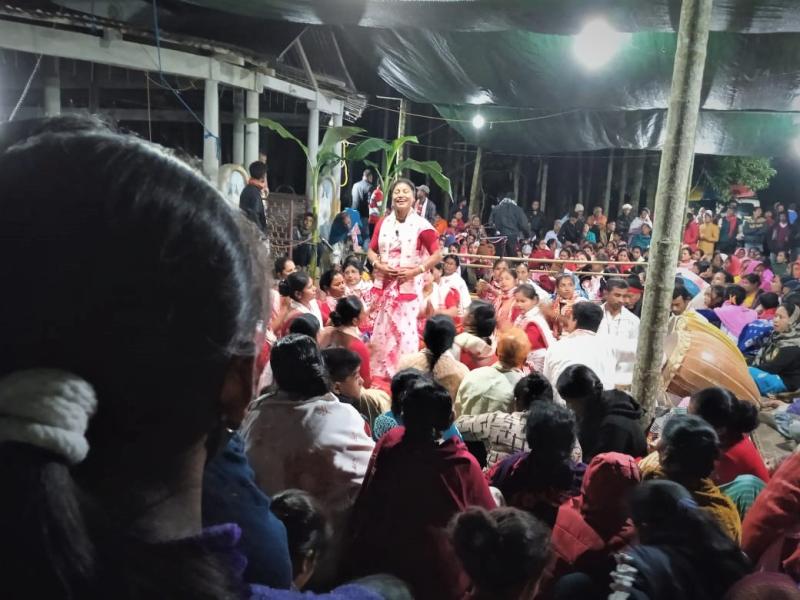
Photo courtesy- Jnyanada Baruah
Coming up of new generation, particularly young women in large numbers have given Nagara Naam a new milieu with enormous popularity across Assam and beyond. Most of these young generation artists take the help of digital technology to showcase their talent and to connect people.
The per performance remuneration of a reputed team varies between Rs.18,000 to Rs.20,000. For newcomers it ranges between 10,000-12,000 per performance. The money is later divided among the team members. The rate for each Pali is Rs.500, for Nagoru Rs.500-Rs.700, and for Taluwoi it is Rs.500 per performance.
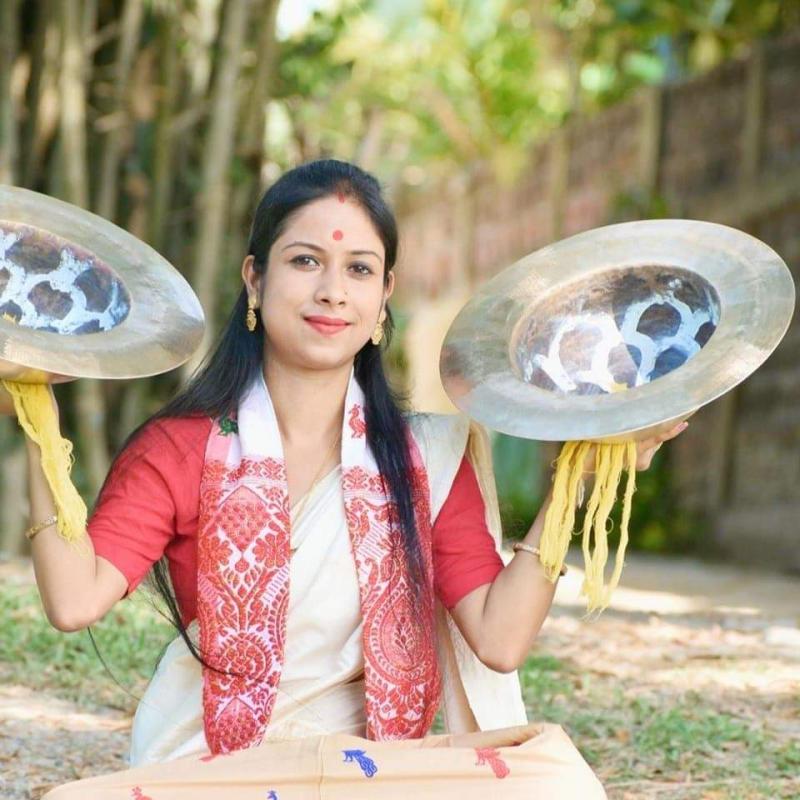
Photo courtesy- Ritusmita Talukdar
The cost of instruments ranges between Rs.70,000-Rs.1,00,000 depending on the size of the team. Price of a pair of Taal with four kilogram in weight costs Rs12,000. The cost of Nagara ranges between Rs.1000-Rs.4000 depending on the size.
Naba Kumar Saikia, the General Secretary of Darrang Kala Kristi Unnayan Sangha, and a senior journalist says active participation of young women in this cultural practice is a recent phenomenon, but such transition has enormous impact in shaping new gender perspective to this unique folk culture.
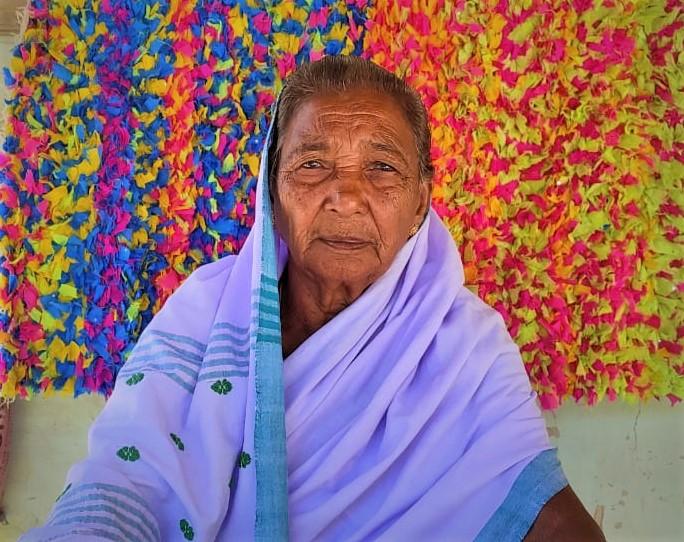
Padmeshwari Nath (Photo courtesy- Dulu Moni Nath)
“These teams of young women are confident and hardworking. They have almost overshadowed their male counterparts. Currently, there are 140 female Nagara Naam teams against 35-40 male Nagara Naam teams in Darrang district. Each team supports 15 to 16 families on an average. They work as a team, earn modest income and support their families with it,” he says.
Saikia says, performance of Nagara Naam is a laborious art form as one needs to perform for several hours at a stretch. The audience is mostly a rural crowd.
“It requires leadership quality, physical strength and mental ability in addition to the expertise in the art-form. In Darrang, these artistes are mostly from poor agrarian families. Many of them work as agriculture labour or other daily wage- earning jobs. They work during day-time and perform during nights. Agrarian crisis has pushed young women from these families to take up this cultural performance also as a livelihood option”, Saikia adds.
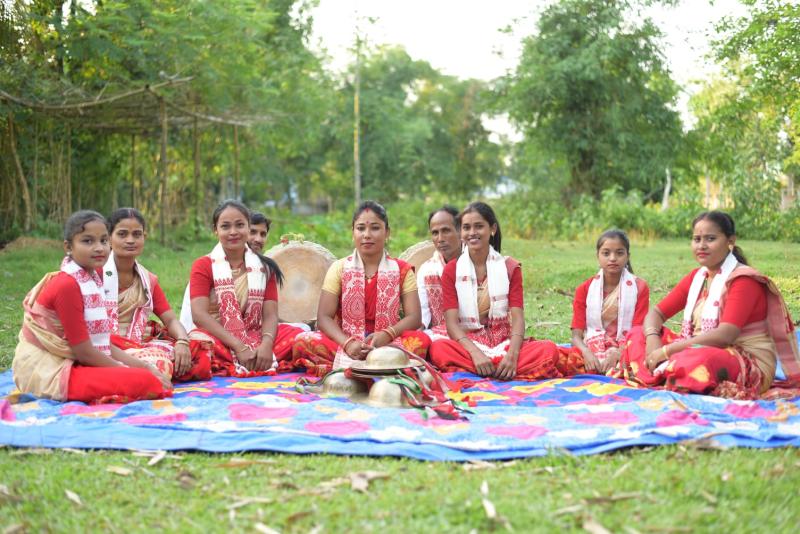
Dulu Moni Nath with her team (Photo courtesy- Dulu Moni Nath)
Till some years ago Nagara Naam was performed primarily on religious festivals and occasions, but now-a-days people love to invite teams to perform in individual family functions such as marriage and birth ceremonies and other household events. Such boom has opened up new opportunities for the performers. During peak seasons of winter, a team performs at least 18 days a month on an average. During the month of Magh, (Mid-January to Mid-February) a performer hardly gets rest.
Dulu Moni Nath (33), a folk artist and a lead performer of Nagara Naam from Dakhin Chuburi village of Darrang district says that most of her Palis of her team studying in different schools and colleges.
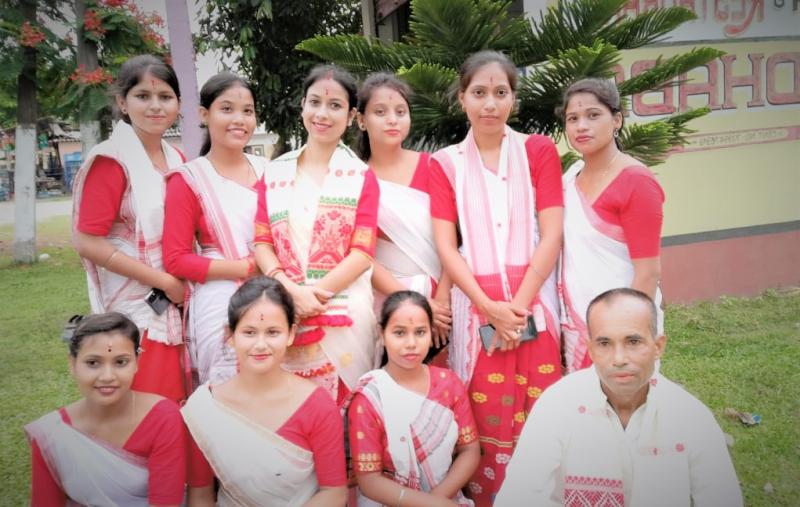
Ritusmita Talukdar and her team (Photo courtesy- Ritusmita Talukdar )
“A nagara Naam Pathak has to do flawless acting while singing the devotional song to the tune of Nagara and Taal simultaneously. The acting part may involve comedy, tragedy or heroic characterisation. According to emotions of different characters of the narration, the Pathak executes the role. The transition is quick, dramatic and awe-inspiring. The lead performer quickly transits from one character to another. A bit of dance-steps too, is essential” Dulu Moni Nath says.
She says the lead artist performs amidst the crowd with very close interaction with dignity and humbleness. There is no gap between the audience and the performers. The role of the Pathak is to draw the entire attention of the crowd.
“It is a challenging task to draw the attention of the crowd for several hours at a stretch. We must remain alert about the mood and reaction of the crowd and instantly think of some interesting elements if they are distracted from the main devotional song”, Naths adds.
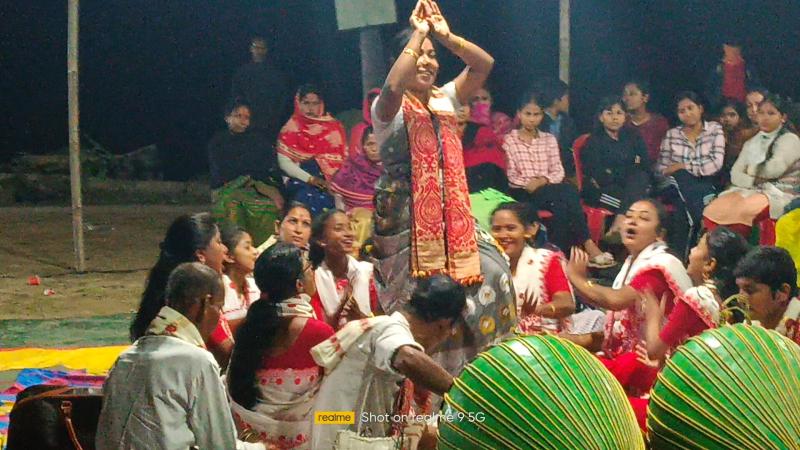
Photo courtesy- Dulu Moni Nath
Dulu Moni’s grandmother Padmeshwari Nath who lives in Borongabari village too was a Nagara Naam Pathak and a folksinger. However, during those days, people only used to perform only as rituals along with other folk songs, she adds.
Jnyanada Baruah(38), a teacher of Patharighat Jatiya Bidyalaya high school belongs to a family of folk artiste in her village. Her uncle late Muktaram Baruah was a renowned Nagara Naam artiste and also received Artiste pension for his rich contribution as a performer of Suknanni Ojapali, a vibrant folk art of Darrang. Both her father and father-in-law used to perform as Palis under Muktaram Baruah. Her husband Atul Baruah is a Nagoru of her team.
“Because of difficult situations such traditions in our village became stagnant, but I decided to take the lead by forming a team three years back. With the money we collected so far, we have purchased all the instruments investing Rs.70,000. We hope we will be able to earn and save some amount from this year,” she says.
Her father Dibakar Barua, a retired teacher and the President of Patharu Samanway Gosthi, while remembering his performances in the Seventies, says: “earlier the devotional songs were directly picked up from the epics, various Puranas and other religious scriptures. The dramatic part of today’s performances was absent during that period. Earlier, we used to perform throughout the night. Nobody thought of money. People who invite us used to offer something as honorarium. Today, things have changed and one can take up Nagara Naam as an alternative livelihood option.”
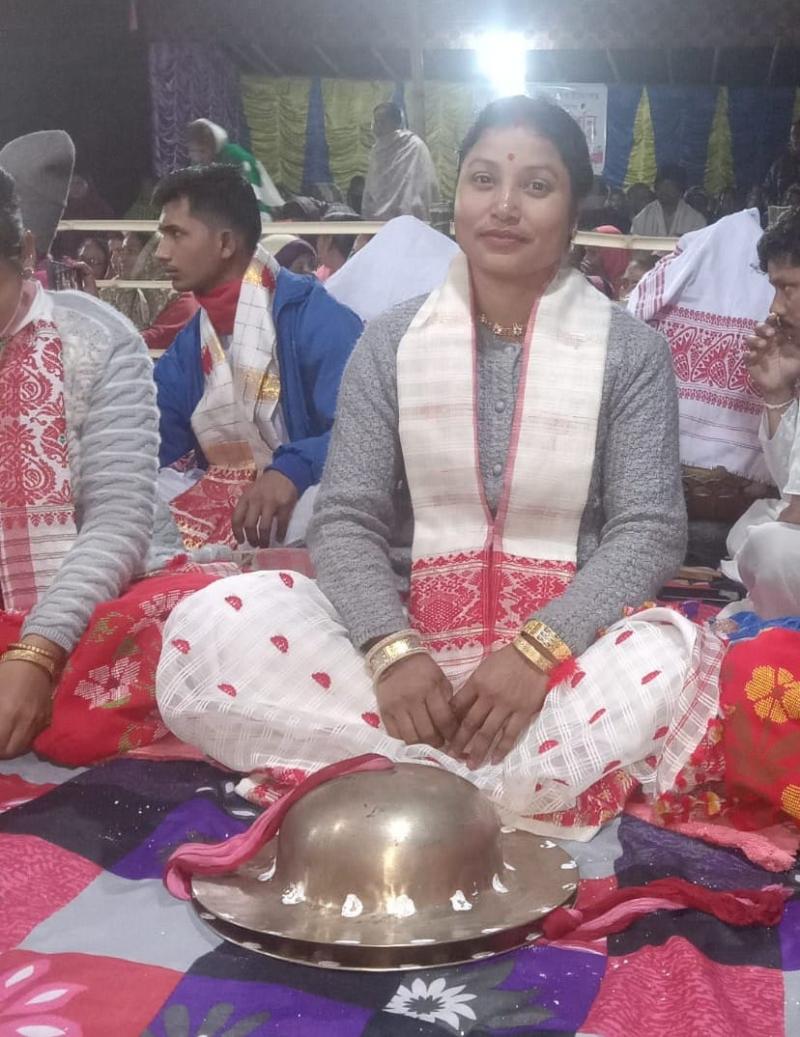
Photo Courtesy - Jnyanada Baruah
Welcoming women’s participation, he says it will provide the unique cultural practice of Darrang a new life. There were very few women Nagara Naam teams in Darrang, and even those lacked consistency. The change has been observed since some years ago, he adds.
There are also instances where these young women have been trolled in social media. At times, they face challenges of patriarchal institutions with the allegations of not maintaining ‘purity’, while performing devotional Nagara Naam. They also faced organizational threat of ‘banning’ with such allegations. However, these groups of young women dare to take the challenge and perform in different places during daytime and even during night with constant support from mass people.